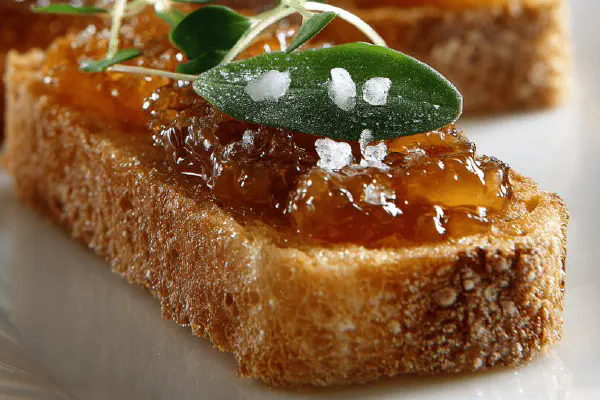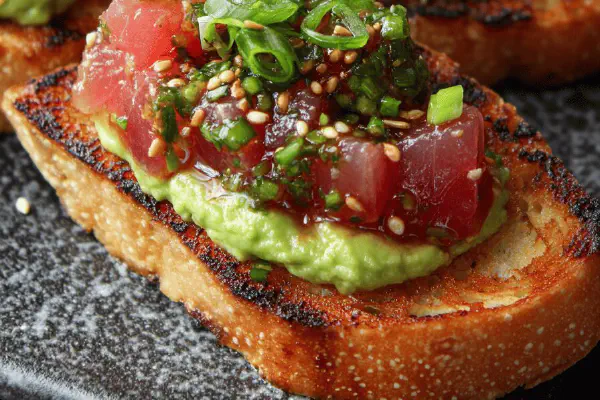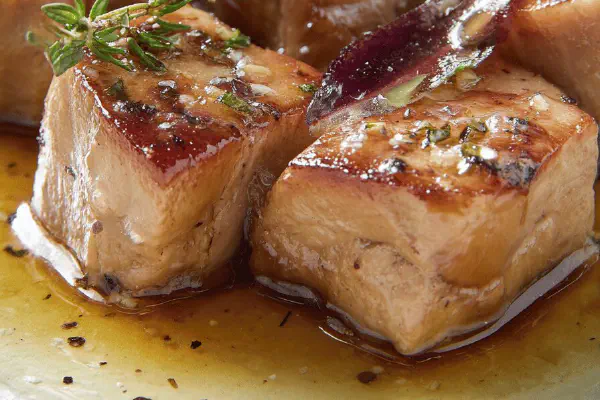Foie Gras Apricot Bites

By Emma
Certified Culinary Professional
Ingredients
- 16 thin slices brioche or rustic bread
- Torchon foie gras slab
- Peach preserves instead of apricot jam
- Fresh tarragon instead of chervil
- Light sprinkle sea salt
About the ingredients
Method
- Preheat oven to 190C (375F).
- Lay bread slices on baking tray. Toast 6 minutes until golden edges. Remove. Cool slightly.
- Slice foie gras into thin pieces, about same size as bread.
- Place foie gras slice on each toasted bread piece.
- Add ½ teaspoon peach preserves atop each foie gras layer.
- Decorate with small sprig of fresh tarragon. Lightly salt.
- Serve immediately or chill briefly.
Cooking tips
Chef's notes
- 💡 Oven temp crucial. Preheat fully to 190C. Bread needs even, light golden toasty edges. Timing 6 minutes standard but watch bread thickness. Too thin burns fast. Let bread cool 3-5 mins post-toast. Hot bread will soften foie gras, mess texture. Foie gras slice thickness matters. Thin but firm slices retain shape during layering. Sharp knife needed. Preserve scoops measured half teaspoon each. Keeps sweetness balanced. More jam means soggy or overpowering layers. Herbs tiny sprigs only. Tarragon is strong—small leaf size keeps bright without drowning flavors. Salt sprinkle last. Too early salt here won’t dissolve, stays crunchy and distracting. Serve fast or chill max 10-15 mins.
- 💡 Bread choice shifts final texture. Brioche soft, rich, sweeter base. Rustic offers chew and bite contrast. Slices best at quarter-inch thickness. Toast crisp but tender. Foie gras torchon style critical for firm consistency; other types too soft or crumbly. Peach preserves swap apricot moves flavor to sweeter, floral side. Select natural preserves for cleaner taste, no heavy additives. Herbs can change aroma drastically. Tarragon brings anise sharpness unlike chervil’s soft green note. Parsley or basil substitutions possible but shift flavor balance. Use sea salt flakes or fine dry salt—not oily or wet. Minimal oil or butter used anywhere. Assembly speed matters; build quickly after bread cools to avoid sogginess.
- 💡 Assembling order key. Toast first, cool slightly. Foie gras next, fully sliced, single piece each toast, centered. Then dollop preserves precisely half teaspoon. Overdoing jam sinks bread and covers foie gras mouthfeel. Herbs add freshness, small sprigs only, placed carefully to avoid overpowering. Salt at end, just before serving. Rushing starts melting foie gras and softening toast—texture lost. Chilling briefly can firm preserves slightly, but avoid long refrigeration. Packing for transport better in parts or tightly wrapped to keep crispness. Avoid coarse salt flakes that dominate. Layer sizes uniform for even eating experience and flavor bite per bite.
- 💡 Timing sequence essential. Preheat oven first, so toast time exact. Bread turn golden but don’t darken too much or bitter notes. Cooling after baking key step. Use sharp knife for foie gras slices—torchon style’s dense texture holds shape better. Half teaspoon preserves ensures control over sweetness, avoid puddling. Herb size governs aroma intensity. Tarragon is pungent. Light salt sprinkle finishes taste, sugar-fat balance depends on it. Multitasking example: toast bread, prep foie gras slice, clean herbs, measure preserves simultaneously to meet quick assembly timing. Toast thickness influences heat penetration and texture contrast too. Experiment slightly by bread type for personal preference.
- 💡 Serving note: bite-sized only. One slice, one foie gras piece, small jam dollop - easy to handle. Richness calls for moderate portions. No nuts, dairy, eggs—safe for allergies but watch for salt input if sensitive. No extra garnish needed; salt flakes make enough flavor pop. Combine with acidic drinks or sparkling wines to cut richness. Transport in layered, separated containers if away from home. Chilling short time okay but not long; preserves soften toast if held too long. Presentation simple, minimal fuss keeps focus on layered ingredients. Salt last keeps freshness alive. Each element counts towards final mouthfeel and aroma balance.
Common questions
Can I use a different bread?
Yes but adjust for thickness. Brioche softer, rustic chewier. Toast timing varies then. Thicker slices need longer. Thin slices crisp easier but risk burning. Keep slice uniform. Rustic adds texture contrast. Brioche milder flavor. Work your oven; watch bread carefully.
What if I don’t have torchon foie gras?
Other foie gras types exist but texture differs. Torchon dense and firm, easy slicing. Other styles fragile, crumbly. Can try chilled pâté but spreads differently. Heat sensitive too. Keep slices cold to hold. Alternative: smaller chunks but risk uneven bites. Texture affects overall mouthfeel importantly.
How to avoid soggy bread?
Toast well, cool before layering. Preserve measured small amounts, half teaspoon max. Assemble quickly after cooling. Foie gras layer first protects bread from jam moisture. Salt last to prevent early moisture draw. Short chilling okay, long refrigeration ruins crispness. Toast thickness matters; thicker bulkier toasts handle moisture better but less delicate.
How to store leftovers?
Best fresh but if needed, wrap tightly, refrigerate. Bread softens fast though. Foie gras and preserves separate keep best. Reassemble before serving. Short fridge time, no more than 24 hours. Avoid freezing, texture lost. Transport separate components to keep crisp. Serve within hours of prep for best mouthfeel and flavor contrast.



